
Many of us have felt the frustration when a Wi-Fi signal is not good enough to hold a solid connection to our device. Wi-Fi extenders and repeaters can be used to extend range, but due to the nature of the wireless medium, in many cases such installation will fail to provide the desired bandwidth. Furthermore, it is also required to pre-define roles and responsibilities for each device. The access point (AP) will have to be placed in locations that will permit providing service to all of its clients and this fixed positioning has to be maintained to preserve network connectivity.
Wi-Fi mesh networks have disrupted these two basic assumptions. Every mesh node is equivalent to the others, which makes the network independent, with a self-forming capability. After an initial setup, the device can be located wherever it’s needed; it can act as an endpoint, a range extender and even a gateway to an external network. A mesh network can rearrange itself using a self-healing mechanism, to support cases in which some nodes have changed their position or have been turned off.
With such capabilities, new use cases and topologies for Wi-Fi technology usage have been opened up. These use cases range from a closed loop system that supports machine-to-machine (M2M) topology, through a home automation deployment and up to a smart grid use case that can be constructed using a huge number of hops and nodes.
The mesh-capable device might have only basic IEEE 802.11s features and be able to construct a mesh network, or it can be loaded with more sophisticated features like precise synchronisation between devices, concurrent operation of the mesh and other Wi-Fi roles, dynamic transition between mesh network and AP-based network, and so on.
However, mesh networks have a major consideration on the bandwidth they can handle. As the best path to transfer data from one point to the other can constantly change, it is crucial to determine the best route in a dynamic, reliable way and as quickly as possible. Although there are many routing algorithms out there, it’s not a trivial task to fine tune the best path selection algorithms to achieve optimal Wi-Fi behaviour.
Mesh network use cases
A mesh network can be used for a wide variety of scenarios, outside of the basic capability to transfer data over a distributed deployment. There are several advanced capabilities that might be required from mesh devices in order to support most of the use cases.
Ethernet bridged mesh station (STA) is a simple and robust way of creating a mesh network, leveraging its benefits without overloading any existing infrastructure and even taking advantage of a separated channel. When reliable and high-performance data transfer is required, this should be the selected configuration. A great example of this is wireless audio speakers where the music is played across multiple devices, sometimes out of range of the home AP.
Concurrent operation of mesh STA and AP roles can be used to allow connection of legacy station devices to a mesh network. This can be very useful in M2M scenarios where the devices are all connected to each other through the mesh network but can be controlled and accessed through STA devices handled by the operators.
Concurrent operation of mesh STA and STA roles can be used to connect the mesh network to a standard AP infrastructure for Internet access, which is a huge advantage for home automation devices. In such a configuration, all of the appliances will connect to each other seamlessly and will form an independent network which can be used to pass information between them while reducing the dependency on the home AP. A single device connected to the home AP will provide Internet access when needed.
In a configuration implementing dynamic transition between STA and mesh STA link establishment, there will be just a single active link the majority of the time, as opposed to the case where both links are kept concurrently. The transition will be based on the device’s needs. If there is a good link quality with the AP, the STA link will be kept, allowing the use of the legacy power-save schemes. Once the link with the AP is degraded, the device will use the mesh STA link to improve its performance.
An extended feature is precise synchronisation between mesh devices. For STA devices this is a trivial and required capability, by the IEEE 802.11 specification, to allow AP beacon tracking, power-save mode operation and more. For mesh STA, this is not mandatory but it can be very helpful when a master clock is required to align all of the devices. Such a feature can be used when synchronised music is played between speakers in the same room.
The above advanced capabilities have two common key advantages which translate into the main mesh use cases:
1. Range extension use case
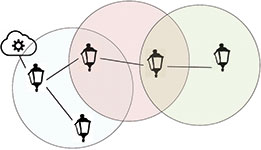
One of the major benefits of mesh deployment is the possibility to pass data between two devices that are not in range of each other. This benefit is created by taking advantage of the connection to the mesh STA devices in between. Devices can be connected in a row, one after the other, forming a chain of nodes (somewhat like a chain of city street lights). Since each added hop has an impact on the throughput and the latency of the transferred data, the number of links in such a chain, and the location of the external network connection, should be adjusted to meet the expected network performance.
A classic example of chaining is city lights, connected to one or more external network APs, allowing wireless data transfer, status reports and remote control using standard Internet protocol (IP) infrastructure. Another common deployment example is wireless speakers, where there is one speaker connected to an Internet music streaming service and providing that connection to all other speakers in that network. A mesh network can easily double the range of the Internet access and enable dynamic positioning of speakers around the house.
2. AP offloading use case
The demand for wireless bandwidth within a specific network is constantly increasing; more and more mobile devices are streaming video and audio content with high-quality requirements. Using a smart mesh deployment can actually offload some of the load from the legacy AP device by enabling direct data transfer between the devices.
Again, one of the most common examples is the wireless audio speaker scenario. Today, many audio services can support multi-speaker streaming playback.

The audio source can be an Internet music streaming service, such as Spotify, Pandora, TuneIn, etc., or local content played through Digital Living Network Alliance (DLNA) services. In any of these cases one of the devices is selected to be the ‘master’ of the network and it is the one supplying the content to the rest of the speakers. With the legacy AP-based topology, all the information has to go through the AP to get to the other devices, as demonstrated in Figure 2.
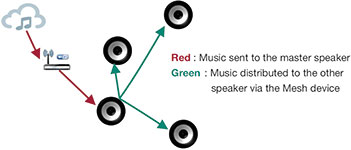
Using the mesh network can significantly reduce the load on the AP and help utilise the air medium more efficiently as the speakers can transfer data directly from one to the other, as shown in Figure 3.
Wi-Fi mesh key features
Homogenous
Wireless mesh networks inherit capabilities from legacy AP/STA modes. Each mesh device acts as an autonomous basic service set (BSS) which is reflected in the beacons’ transmission, connection handling and so on. There are no pre-configured roles for the nodes, which makes the network highly flexible and simplifies the deployment.
Self-forming
The wireless local area network (WLAN) mesh is defined as a self-forming network. The detection of other mesh devices is done by listening on a selected channel for the presence of other devices with mesh dedicated information elements (IEs) in its beacons. A suitable mesh device is one that has the same network name and uses the same security protocol. Once the suitable network is detected, a connection will automatically be initiated. The connection can be open or closed (secured) using a pre-shared key.
Dynamic path selection
One of the key concepts of a distributed network is redundancy of links in the system. This redundancy allows better resilience to node failures and allows multiple options to reach from one point to the other. Together, it imposes the challenge of selecting the best path to the desired destination.
Process description
A mesh station uses a built-in algorithm to compute a path cost, or metric. For each destination, it will be required to calculate the optimal path with the lowest link cost/metric. This is done by incorporating the hop count, signal quality, data rate and more.
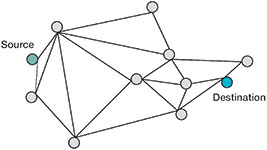
The path selection process is invoked periodically, even if the mesh network is constructed as a stationary network. This is required since the air conditions might change, a device might change its position or disappear, and the connection quality between devices that currently construct the best path might become worse (see Figure 4).
The path selection algorithm selected by the IEEE to be incorporated into the specification is hybrid wireless mesh protocol (HWMP). It is divided into two main modes – on-demand and proactive – to meet the needs of different mesh network topologies and use cases.
Proactive mode
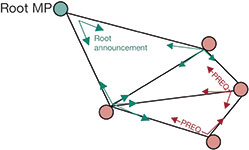
In this mode, once one or more devices are defined as a root mesh device through a root announcement frame, all the other mesh devices will start to form a path towards that node. The path selection process will be periodically invoked even when there is no data to be sent. Due to the large amount of packets continuously transmitted in this mode, it can impact utilisation of networks with a high number of nodes and thus is not recommended. Figure 5 shows the process.
On-demand mode
The on-demand path selection mode is the default operation mode in the 802.11s open-source solution since it meets the needs of most of the scenarios and topologies. Also, it improves power consumption and network utilisation since it will be triggered only when data is required to be sent.
When a source has data to transmit, it sends a broadcast path request (PREQ) which propagates through the network nodes. The destination receives all the PREQ frames and replies with a unicast path response (PREP) to the device, constructing the best path to the source. PREP is forwarded by intermediate nodes until it reaches the source.
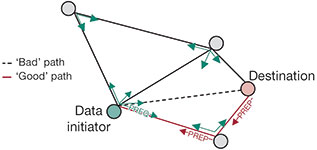
What might be counterintuitive is that the responsibility for determining the best path is made by the destination mesh STA and not by the originator, while the other nodes along the best path are used for passing the PREP frame from the destination toward the data source. Figure 6 shows the process.
Intermediate nodes that pass the PREP will also capture the path cost to adjacent nodes. This is valuable to allow sharing of the metric information and reduce the packet distribution. On the other hand it can cause these nodes to capture the non-optimal path and result in a performance impact.
Self-healing
The self-healing mechanism is responsible for detecting mesh devices gracefully leaving the network or an abrupt disappearance, and takes immediate corrective action. In both cases, once identified, the data source will have to construct a path toward the destination. The time for the whole process has to be quick to prevent data loss and high latency. A good response time is considered to be within the range of 0,5 to 2 seconds.
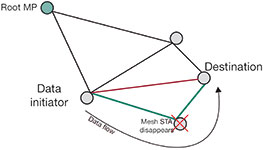
Possible issues in mesh networking
Path metric
The air metric calculation described in the specification is based on the effective transmission rate and the packet error rate. In many cases, mesh devices either have outdated rate information, or lack it entirely. As a result, they will not reflect the real current state and a wrong path will be selected.
In fact, in any case where the data initiator has unidirectional data sent, like user datagram protocol (UDP), intermediate nodes will not have any reliable information on the link quality and the optimal path will not be selected.
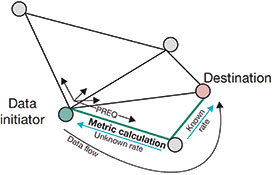
Path selection process reliability
As described above, the path selection process starts with a broadcast transmission of a PREQ frame. In general, broadcast transmission is not reliable as unicast (to a specific destination) as it doesn’t require an acknowledgement and it doesn’t have any retry mechanism. As a result, reception of packets at the destination is not guaranteed, particularly in the mesh device that constructs the next hop of the preferred path. Moreover, since the broadcast frame is forwarded by all mesh devices until reaching the destination, its propagation might be broken over the better path at any node and be successful over some path with poor conditions.
The reason for such an incident can easily be explained. Figure 9 shows the data flow over the best path, which means that the air around these mesh devices is congested with the WLAN transmissions. When the path selections start, broadcast PREQ frame transmission has, as with any other frame, some probability to get lost due to collision. In this case, PREP will be sent over the poor link, the path will be switched and the performance will be impacted. In the next path selection cycle, figuring the optimal path will be attempted again, and it’s quite possible that such a phenomenon will occur again.
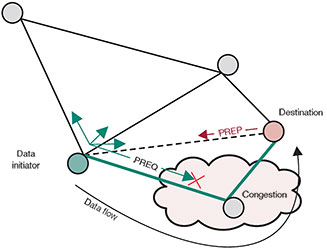
WLAN mesh deployment considerations
When deciding to use a WLAN mesh solution, additional considerations should be taken into account. Those parameters will also have an impact on the overall system’s behaviour. A few of them are described below and should also be considered during the network’s planning.
Number of hops
When considering a scenario of a network that is constructed as a chain of devices, it should be noted that such a topology might have some limitations. These limitations are reflected in the network’s performance in terms of bandwidth and delay.
Theoretically, this chain might be unlimited in the number of hops through it; however the data’s propagation through such a network might have a very large delay accumulated when moving from device to device. Also, the maximum data throughput that will be able to flow through a large number of hops will be limited due to the air access process in the wireless network. However, adding intermediate points defined as gateways to permit data’s exit will not constrain the data to propagate from edge to edge or through a large number of hops.
Number of devices
It is known that the total bandwidth for WLAN operation has some physical limitation value. This maximum bandwidth will be divided between all devices connected on the same channel and within the same range. Mesh flexible positioning and configuration might come in handy in cases where there is a need for a large number of devices.
Dividing the network into clusters and leveraging the mesh range extension capabilities will increase network usability and overall performance.
Hidden nodes
In the case of large-scale or long-range networks, the key aspect of hidden nodes must be taken into consideration. This refers to the situation when devices don’t, or almost don’t, hear each other, but still operate on the same channel and contest access to the air.
In an AP-based network, such a process is easier to control due to the centralised nature of the network and a dedicated protection mechanism. In contrast, in a mesh network, the same protection mechanism will not always resolve the hidden nodes situation. Network designers therefore need to be aware of such wireless-based network problems and design the network properly.
Connection radius
The wireless network permits connections between devices even if they are located at the edge of the lowest rate sensitivity level. Such a connected device will be able to operate most of the time at the lowest modulation rates, which requires a long air time allocation and, as a result, significantly decreases bandwidth. This option is essential when this is the only way to permit some device to join the network, but can be devastating in a network that doesn’t require such a rescue state and might require an alternative solution.
In mesh networks, optimising the sensitivity threshold will permit the network to operate effectively in terms of rate usage and limit the number of connected devices to one device, thus distributing the network’s load and increasing the total bandwidth (see Figure 10).
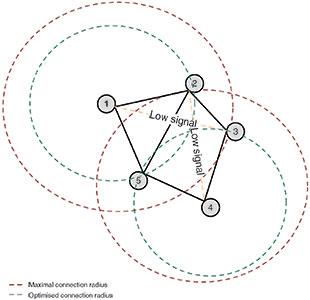
The Wi-Fi mesh solution from Texas Instruments
The Texas Instruments WiLink 8 combo connectivity device has an integrated solution for the wireless mesh network, using Wi-Fi technology. It is based on the IEEE 802.11s, MAC80211 open-source implementation. It permits a dynamic range of configurations, standalone and combined operation with other modes. Most importantly, it provides a reliable and robust implementation that overcomes many of the challenges described above to allow high-quality products to leverage this technology.
Although the basic 802.11s open-source implementation has been available for a few years, it has not dealt with many challenges when trying to achieve stable, high-throughput results. TI’s WiLink 8 Wi-Fi-based mesh network solution enables developers to better overcome these challenges.
Path selection
As stated before, path selection is the core algorithm of the mesh network. It can make the network performance great or unusable. TI’s WiLink 8 software implementation uses the on-demand mode as it meets the needs of most real-life scenarios. It preserves the basic concepts that allow for better power consumption, air utilisation and dynamic deployment, while getting around the reliability downfalls.
The WiLink 8 solution will consistently find the best and most stable path toward the destination on every path selection cycle in regular conditions. One other key improvement is adjusting the air link metric calculation in case of obscurity of the effective rate toward the mesh device to which this calculation should be invoked.
The following example compares the data flow in a legacy 11n connection versus three WiLink 8 devices forming a mesh network. In both cases, the destination device is getting further away from the data source. Such a test is usually referred to as RvR (rate vs. range), where range is simulated using a variable attenuator between the nodes. In a mesh network the variable attenuator is adjusted linearly, causing natural rate degradation and triggering the path selection protocol to alternate the data flow to the best path.
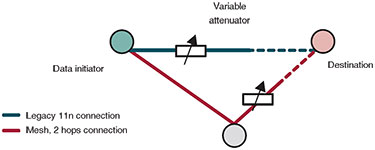
Figure 11 shows the setup and the data flow when the variable attenuator changes across the direct link and then across the second hop link. Figure 12 shows the rate selection at different attenuation levels. It can be clearly seen that at the 89 dB mark, a new path is selected; stopping the rate drop and allowing a stable data path for a longer range.
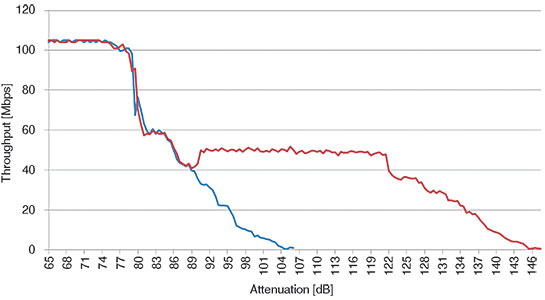
Referring to the reliability problems described in the section entitled ‘Path selection process reliability’, whereby the path selection might suffer and the wrong decision may be taken, the WiLink 8 solution provides a highly reliable path selection process, better propagation over the network and the final correct decision even in a vulnerable network.
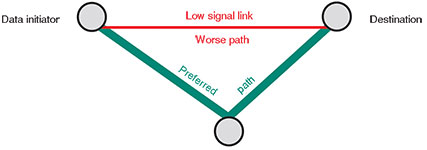
The basic mesh network topology shown in Figure 13 describes the setup for path selection reliability analysis. Figure 14 shows the reliable path selection behaviour, reflected in the stable data flow over the Wi-Fi based mesh network.
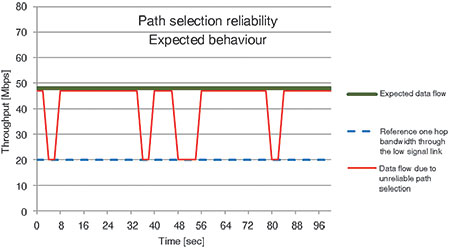
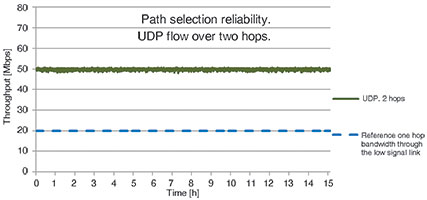
Figure 15 shows the real result tested for the scenario described in Figure 13. It compares the actual throughput result with the stable path selection decision to use a two-hop path versus a pre-measured throughput as if only the direct path had existed.
Bandwidth example for multiple hops
To emphasise the importance of choosing the correct Wi-Fi-based network type, an example of a mesh network, including targeted use case needs, with a multi-hop topology is presented in Figure 16.
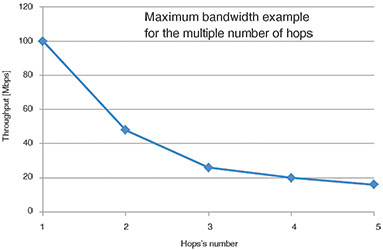
This example shows that, due to the inherent Wi-Fi-based network nature of air access and the bandwidth share, the network performance decreases significantly in the initial hops but stabilises over the following hops, maintaining a bandwidth that will suit many applications.
For more information contact Dirk Venter, Arrow Altech Distribution, +27 (0)11 923 9600, [email protected], www.arrow.altech.co.za
| Tel: | +27 11 923 9600 |
| Email: | [email protected] |
| www: | www.altronarrow.com |
| Articles: | More information and articles about Altron Arrow |
© Technews Publishing (Pty) Ltd | All Rights Reserved